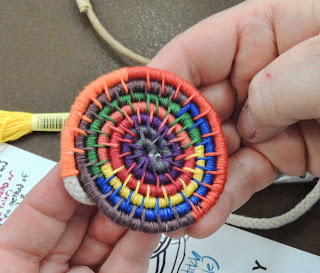This is a continuation of projects that study group members did as a results of their study about shadow weave.
Ingrid K. took a twill line and used a Fiberworks' feature to create the parallel threading on 16 shafts.. Her tie up reflects the Lang & Voolich method described in their monograph, “Parallel Shadow Weave”.
I (Beryl Moody) did my experiments on a draft from Marian Powell's book 1000 (+) Patterns In 4, 6, and 8 Harness Shadow Weaves. My processes have been recorded, along with photos of my towels and drafts, on my personal blog, Banner Mountain Textiles.
____________________________________________________________________________________
Resources for our Study.
When our guild has a study group topic, we try to gather all of the available information we can find so that our group members can pick and choose what makes the best sense for them individually. This study was no exception.
Available Information about Shadow Weave
Our group talked about the new book The Enigma of Shadow Weave Illuminated by Rebecca Winter and then pointed out the fabulous FaceBook group "Color-and-Weave (formerly Shadow Weave in color) that is moderated by Rebecca.
One resource that I found very helpful was the Long Thread Media "Introduction to Shadow Weave" video course done by Jannie Taylor. Her explanations about how to convert a profile to a thread by thread draft and her worksheets that I downloaded were invaluable.
Two books that have great chapters with information and shadow weave drafts are A Weaver’s Book of 8-Shaft Patterns edited by Carol Strickler and Eight Shafts: A Place to Begin by Shelp & Wostenberg.
Exploring Woven Fabrics by Janet Phillips has a whole section on Shadow Weave. She also has a pdf document on the subject that you can access through this link. https://www.janetphillips-weaving.co.uk/articles
A last resource, which is very inexpensive, is Heddlecraft, May/June 2016. An individual download, including wif files, is $4.50. This is certainly a great place to begin and the shadow weave article written by Linda Hartshorn is an excellent overview about the subject.
Good Information about Shadow Weave (but hard to access)
There is the illusive and very hard to access monograph, Parallel Shadow Weave by Lang and Voolich, which we found could be checked out through an interlibrary loan.
Marian Powell's book, 1000(+) Patterns In 4,6, and 8 Harness Shadow Weaves, is also difficult to find and afford, even if you do find a copy. I believe you can also borrow this through an interlibrary loan and many guilds have a copy. Armed with the profiles and explanations on how to draft shadow weave from a profile, this book gives you enough options to last a lifetime. Many of Marian’s drafts have been published in Handwoven magazine.
Summary
I found that even though I thought I knew all I needed to about Shadow Weave, I was certainly mistaken. I spent hours translating profiles with a variety of weaving software programs into shadow weave drafts. None of the programs that I used would translate a profile (that changed direction as in a point) would get the shadow to appear correctly in the thread by thread draft.. WeaveIt software, did have a fascinating translation for Lang & Voolich, which was instrumental in leading me down that path.
I hope that our study has inspired you to do your own explorations. Feel free to post your comments and certainly feel free to share your experiences and insights.
Beryl Moody, Reno Fiber Guild















_Page1_Image1.jpg)
_Page1_Image2.jpg)
_Page1_Image3.jpg)
_Page2_Image1.jpg)
_Page3_Image1.jpg)
_Page3_Image2.jpg)
_Page4_Image1.jpg)
_Page4_Image2.jpg)
_Page4_Image3.jpg)










